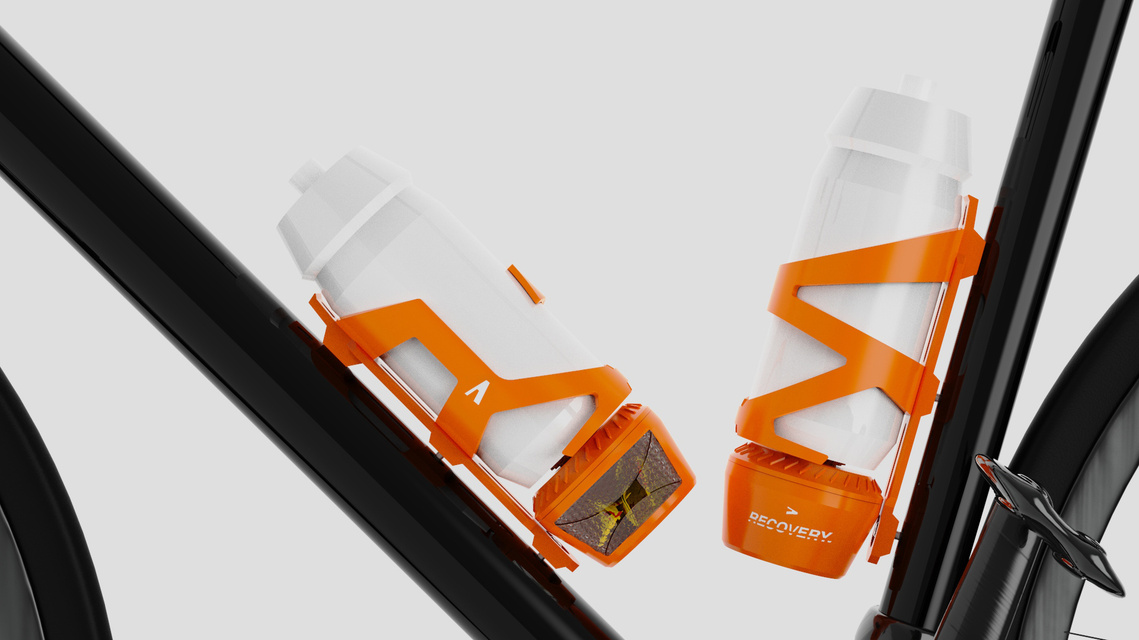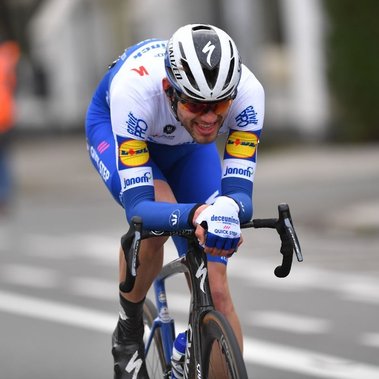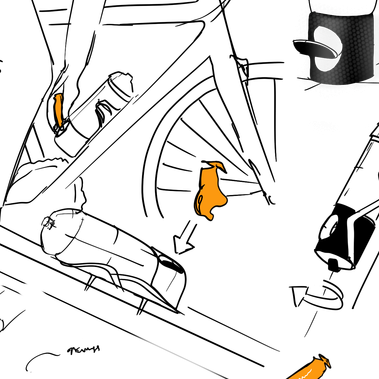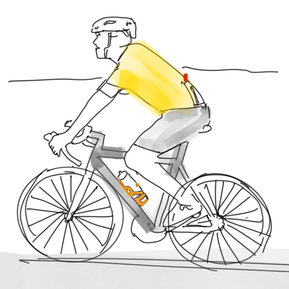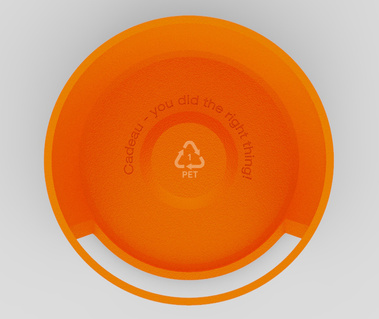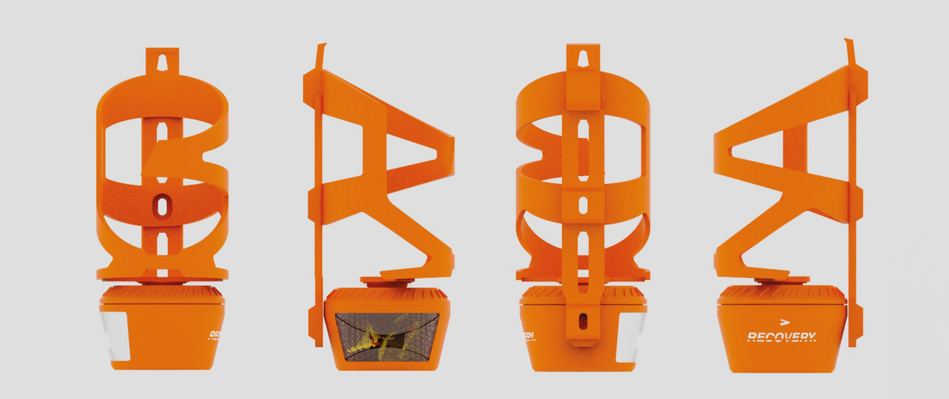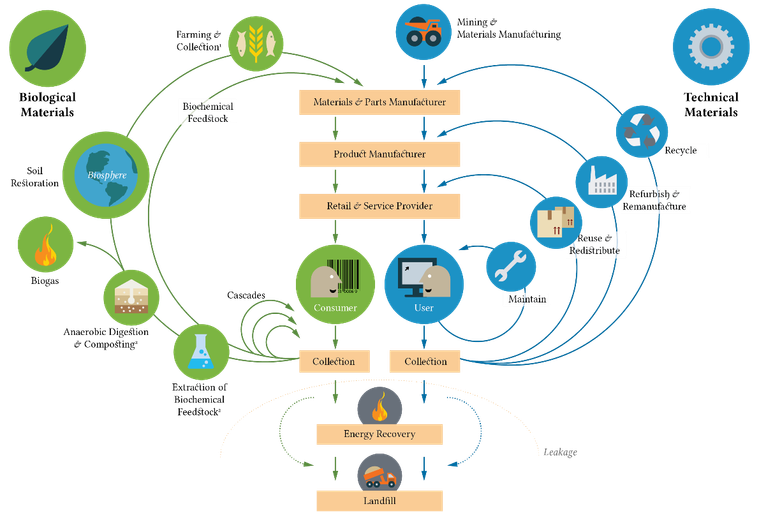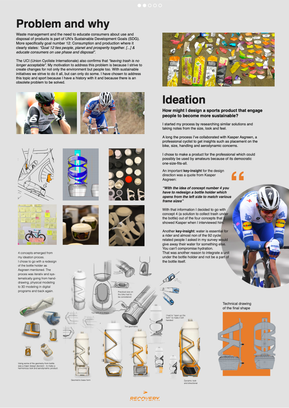Recovery - a modern way to handle trash while on the bike
Sports activities gives joy to everyone but it should not impact the environment as it does today. Cyclists need energy for their bike races but with that, waste is created. Today it either goes into nature or somehow collected in dropzones along the route or put into some jersey-pocket.
Recovery addresses this problem of waste from energy gels and energy bars. With a slick and fast position on the bike the product is made to be used and will not compromise the ride. The product is an integrated bottle holder system with a quad lock system that keeps the unit underneath the bottle tight and in place. It’s easy to implement, mount and re-mount when waste needs to be disposed safely and fast.
With Recovery – you’ll leave nothing in nature
Data
Year: 2020
Assignment: Bachelor Project
Designer: Lloyd Revald
Associate expertise: Design-People Aps
Expert in circular economy, Dan Kristensen
Professional cyclist, Kasper Asgreen (deceuninck-quickstep)
Problem and why
Waste management and the need to educate consumers about use and disposal of products is part of UN’s Sustainable Development Goals (SDG). More specifically goal number 12: Consumption and production where it clearly states: “Goal 12 ties people, planet and prosperity together. [...] & educate consumers on use phase and disposal”.
The UCI (Union Cycliste Internationale) also confirms that “leaving trash is no longer acceptable”. My motivation to address this problem is because I strive to create changes for not only the environment but people too. With sustainable initiatives we strive to do it all, but can only do some. I have chosen to address this topic and sport because I have a history with it and because there is an obsolete problem to be solved.
I started my process by researching similar solutions and taking notes from the size, look and feel.
A long the process I’ve collaborated with Kasper Asgreen, a professional cyclist to get insights such as placement on the bike, size, handling and aerodynamic concerns. I chose to make a product for the professional which could possibly be used by amateurs because of its democratic one-size-fits-all.
Challenge framing and ideation
How might I design a sports product that engage people to become more sustainable?
Concepts, key-insights and interview
4 concepts emerged from my ideation proces. I chose to go with a redesign of the bottle holder as Asgreen mentioned. The proces was iterativ and systematically going from handdrawing, physical modeling to 3D modeling in digital programs and back again.
An important key-insight for the design direction was a quote from Kasper
Asgreen: “With the idea of concept number 4 you have to redesign a bottle holder which opens from the left side to match various frame sizes”
With that information I decided to go with concept 4 (a solution to collect trash under the bottle) out of the four concepts that I showed Kasper when I interviewed him.
Another key-insight: water is essential for a rider and almost non of the 92 cycle related people I asked in my survey would give away their water for something else. You can’t compromise hydration.
That was another reason to integrate a unit under the bottle holder and not be a part of the bottle itself.
Solution: Recovery
- To make the product a relevant solution it had to have space for 4-5 empty gels and not compromise performance and convenience
Furfilling user needs is essential for a sustainable option to be implemented and adopted. That’s why the concept has been build around three driving forces: usefulness, durability and enjoyable experience. (Chapman, Jonathan (2018), Handbook of Sustainable Product Design). The forces can be seen in the practicality of placement of the product, the material and structure of choice as well as the experience of safely discarding trash - without getting your hands greasy.
Responsible disposal and user journey
The whole idea of the Recovery is build to address responsibility of our waste we produce. My hypothesis and belief is that we are being inspired by the idols and the athletes that we watch push the limits in various sports. If they do something – we want to adopt that behaviour.
It is seen in marketing campaigns like Nike. They inspire people. This product has the same relevance to inspired for a more sustainable behaviour of product disposal. Recovery is easy to install and while you are on your bike it is no problem to simply ride, eat, use recovery and keep riding. To empty the waste - just unscrew the unit and dispose the trash it in a trashcan.
Take off, empty and re-mount
The quad lock system makes it easy to screw 45 degrees off and empty the unit and remount.
Moodboard
Inspired by strong motion and speed. Inspiration comes from usefulness of a carabiner, performance of a formula one car and the durability of a ski boot.
CMF and implementation - who should care?
As a way to put the product into context I have created three possible scenarios for whom to implement the Recovery system.
1. A team. If a team would implement recovery it would show direct commitment and responsibility from both team and riders - ultimately taking responsibility for their trash
2. UCI. Recovery could be a symbol used in cycling. Like many other things on the bike and on the riders, UCI (Union Cycliste Internationale) have an authority to implement rules and guidance for riders and teams. Recovery could be mandatory for all teams to safely dispose their trash from gels and energibars etc.
3. Bike manufacturer or gel producer. If a gel producer would implement Recovery: they would have a solution to their damaging waste which they, at this point don't take responsibility for.
Materials
Dan Kristensen, specialist in circular economy, underlines the importance of making a product out of as few materials as possible and clearly indicating what the product is made out of, so that its easier for the user to recycle it correctly. Systemization like a deposit system is the most successive system we know of today and one that could be implemented in Recovery to keep value to the material in a loop.
This would create value to not only businesses but also planet, people & cycling as a worldwide sport.
Materials used: PLA (made from corn) and reinforced plastic (used for bendable properties but could be switched out)
Form, function and design
The form is based upon the geometry of the bottle itself. It is an extension of the product its carrying with harmonious lines in a strong shape. Recovery has been designed not to be too complicated as the bike itself - but as an accessories as it should.
The shape is designed with respect for production facilities as subtractive manufacturing and additive production with recyclable aspects in the material. If the product would have a digital life, it could well be 3D-printed locally and have no transport and co2 emission as an outcome.
Exploded view
(from left) Screws for attachment on the bike
Bottle-holder-part of Recovery and the one that is attached to the bike
Top of the container with embedded grip and quad-lock
Unit or container to storage of trash
Opening “window” for trash to enter the unit
Details
Circular and sustainable approach
Recovery is a product made to last but also to be reused and recycled
Based upon the Ellen Mcarthur butterfly diagram, Recovery is set to used again and again (and maybe be passed on from a pro cyclists to amatures after some time to be reused: creating emotional storytelling) and keeping the produceres responsible for their actions, pusing them to keep the material in a closed loop. The product is also made of a plastic material that is recycable through a grinding proces to become a either a new version of the product or a new item. With that the product has a meaningful life cycle. Attachment of the product could be done by mechanics as well as the job to safely dispose and re-attach before and after a race.
Sustainable inputs from Sustainability cards (Designskolen Kolding)
Storytelling
Emotional and informative effords embedded in the products DNA creating a storytelling with a motto “Cadeau - you did the right thing”
Reuse
Recovery is set to be used multiple times. After some time it could be passed on and be reused by an amateur
DfSB (Design for sustainable behavior)
In the product I’ve also implementing two of the “four principles” associated with DSfB (Niedderer et al. 2014)
1. Making it easier for people to adopt a desired behaviour
(easy attachment, assembly and easy to use)
2. making it harder for people to perform an undesired behaviour;
3. Making people want a desired behaviour
(aspire athletes to adobt the product to inspire amatures to do the same)
4. making people not want an undesired behavior
The new normal finds its way into cycling - with Recovery
The whole process is made by Lloyd Philip Revald
design, sketching, technical drawing, explanatory doodles, 3D-drawing, posters, renderings, prototyping and photography.

